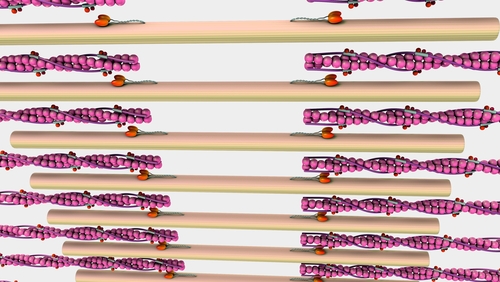The muscular system consists of three main types of muscle tissue. There is smooth tissue, cardiac tissue and skeletal tissue. Muscles make up a lot of the nervous system (although they can be a part of other systems as well). Two certain proteins form the majority of muscles: actin and myosin. These protein strands overlap with one another and allow for muscle contraction and muscle relaxation. Without this, no movement would be able to take place. Nevertheless, to contract and relax, muscles need energy. This is provided for in the form of ATP, most commonly generated through the process of aerobic respiration.

Smooth Muscle Tissue
Smooth muscle tissue is found throughout the body. It is found in lots of different organ systems. However, humans do not have conscious control of these muscles. The muscles work involuntarily, which is why smooth muscles are a part of the autonomic nervous system. An example of smooth tissue is the muscles found in the walls of your intestines. These are constantly contracting and relaxing to move the digesting food along the digestive system. The name of this process is peristalsis.
Cardiac Muscle Tissue
The next kind of muscle is cardiac muscle. You can only find cardiac muscle the heart and you can also call it the myocardium. The sinoatrial node controls the heart by sending out waves of electricity to pass through the heart. Consequently, this stimulates the muscles to contract in a set order. Looking into the circulatory system in more detail will tell you more about the heart. The average heart rhythm is around 72 beats per minute at rest in a normal healthy person. Furthermore, the heart is myogenic, meaning it works without any stimulation from the nervous system. As a result, the heart can carry on beating outside of the body.
Skeletal Muscle Tissue
The final type of muscle is skeletal muscle. Skeletal muscle works by attaching a muscle to a joint via a tendon. This is controlled by the somatic nervous system (rather than the autonomic nervous system like the smooth muscle tissue). The skeletal muscle system provides humans with movement. For example, the maintenance of posture. To stay standing up, skeletal muscles are working on and off to keep you standing upright.
In Humans
Major muscles in humans have names, although most of them are skeletal muscle tissue. However, an exception to this is the heart as it is cardiac muscle. Some muscles in the body act as antagonistic pairs. This means that when one contracts, the other relaxes and vice versa. The main skeletal muscles in the body are:
- Biceps and Triceps (Upper arm).
- Hamstring and Quadriceps (Upper leg).
- Gastrocnemius and Tibialis (Calf/Lower leg).
- Gluteus Maximus (Backside).
- Latissimus Dorsi (Back).
- Pectoral Muscles (Chest).
- Abdominal Muscles (Core).
- Trapezius (Shoulder).
For more information on training courses, visit our “Courses” page which also includes our First Responder and First Person on Scene (FPOS) courses. If you have any queries, don’t hesitate to contact us via our website or call us on 01206 805359.
